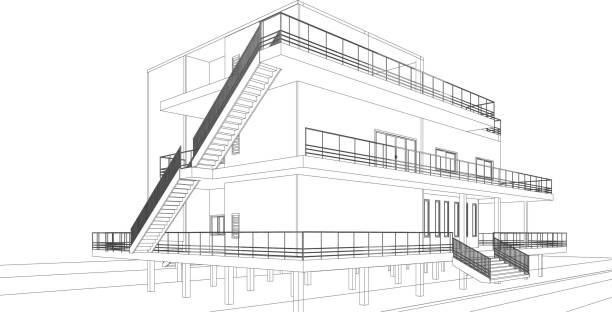Step-by-Step Guide to Evaluating Land for Multifamily Development
When you decide to develop a multifamily project, one of the biggest risks is choosing the wrong parcel of land. What looks like a good deal on paper can turn into costly surprises—zoning issues, unstable soils, utility delays, or community opposition.
Table of Contents
ToggleAt JDJ Consulting Group, we often see projects delayed or budgets overrun because early evaluation steps were skipped or rushed.
This guide gives you a step-by-step process to examine land through multiple lenses — market, legal, physical, and financial,. So you can make smart go/no-go decisions before sinking too much time or capital into design or purchase.
By following these stages, you’ll reduce surprises and ensure your projections are realistic.
In this article, we’ll cover:
- How to understand the market demand for various unit types
- What zoning and regulatory rules you must verify
- Physical site check-points (topography, soils, utilities)
- Environmental and hazard screening
- How to build a solid pro forma to evaluate investment returns
- Legal and entitlement risks you can’t ignore
- Tips for engaging stakeholders, timing, and minimizing risk
📊 Development Costs vs. ROI
Source: NAHB, Statista 2024
Executive Summary & Quick Go/No-Go Checklist
If you’re the kind of person who likes to scan a document fast, here’s a one-page summary plus a checklist you can use on your next land site visit. Think of this as your “first-pass filter.”
| Key Question | Why It Matters |
|---|---|
| Does the market support multifamily housing in this area? | Demand, rents and absorption rates determine whether your revenue model works. |
| Is the current zoning compatible with your desired density / unit mix? | If you need a zoning change, expect delays and cost increases. |
| What is the buildable area after setbacks, easements, and slope constraints? | Reduces your usable space; reduces number of units possible. |
| Are utilities (water, sewer, gas, power) nearby and sufficient? | Bringing services in can be a major cost bump. |
| Are there environmental or hazard concerns (flood, contamination, protected lands)? | These can require mitigation, raising costs or delaying the project. |
| What are the entitlement and permitting timelines? | Time is money—waiting on approvals can kill your carry costs. |
| Does the land cost make sense under your target return? | You shouldn’t overpay; price must match projected value. |
If your answers are mostly “yes” above, then the land may be worth pursuing. If more than two are “no,” you’ll want deeper study or better deal terms.
Market Analysis & Demand Study: Who will live here, and at what rent?
Okay, now we’re getting into the first technical leg. You want to understand who would rent or buy in this project, what kind of units, and how many—before you commit. This helps you size the product, set realistic rents, and avoid overbuilding the “wrong kind” of units.
Demand Drivers & Demographics
- Population growth: Is the city or county growing? Are new households forming (young adults moving out, families splitting off)?
- Job centers / commuting patterns: Do people work nearby or will they commute long hours? Areas near employment hubs tend to have stronger demand.
- Income brackets: What is median income in the area? Is there a gap for workforce housing, or demand for luxury/furnished units?
- Age & household size: Singles, small families, seniors. All have different unit preferences (1-bedroom vs 3-bedroom).
- Lifestyle factors: Proximity to transit, schools, parks, retail. Walkability has become very important in many markets.
Competitive-set Survey
- Look at existing multifamily buildings in the region: What unit types are most common (studio, 1-bed, 2-bed)? What are current rents, vacancy rates?
- Review upcoming competition: What new projects are under construction or in planning? They’ll affect your absorption timeline.
- Amenities: What do competitors offer (parking, gym, shared spaces, coworking) and how are they priced?
Product Positioning & Unit Mix Recommendations
By combining what you learn from demand drivers and competition, you’ll decide:
- What mix of units makes sense (for example, more 1-beds and 2-beds if singles and couples dominate; add 3-beds if there are many families).
- What style / level of finishes will match what renters will pay for (high end vs moderate)
- How many amenities to include vs what you can get away with basic to maximize your return.
Data Tools & Sources
Here are useful tools to help you do this work reliably:
| Data Source | Use Case |
|---|---|
| Local government census / planning reports | For population, household income, growth forecasts |
| Real estate market reports (CoStar, Yardi Matrix, others) | To see recent rents, comps, pipeline projects |
| Brokerage interviews / on-the-ground leasing agents | Good for “sense checks”—what tenants are asking, concessions, vacancy |
| GIS mapping / transit maps / walk-score | Helps with location premiums and lifestyle value |
Zoning, Land-Use, and Regulatory Review: Can You Actually Build What You Want?
Before you get too far, you need to confirm whether the site’s zoning allows for the type of multifamily development you’re imagining. It’s common for developers to find a parcel that looks perfect—only to discover it’s restricted by zoning laws or overlays.
Understanding the Base Zoning
Every parcel has a zoning designation set by the local city or county. That designation spells out:
Permitted uses (e.g., residential, commercial, mixed-use)
Density limits (units per acre)
Height restrictions
Floor Area Ratio (FAR) — how much building area you can place on the land
Setbacks and parking requirements
If your intended multifamily project doesn’t fit within these parameters, you’ll need to apply for a zoning change or conditional use permit.
🛠️ Real Estate Development Planning Process
Source: Urban Land Institute
Special Overlays, Districts, and Local Plans
In many cities, the base zoning is just the starting point. There may also be:
Transit-oriented overlays that encourage higher density near train or bus lines
Historic preservation districts with strict design standards
Coastal or hillside overlays in areas like Los Angeles, which add environmental review steps
Specific plans created for certain neighborhoods that override the base zoning
These layers can either help you (through density bonuses) or create obstacles that extend your timeline.
Ministerial vs. Discretionary Approvals
Ministerial approvals: By-right permits that staff can approve if you meet the code.
Discretionary approvals: Require public hearings, staff reports, and often carry political risk.
Knowing which path applies will help you estimate both schedule and cost. Check the difference of both approvals in this blog.
Practical Steps
Pull the official zoning map and code for the parcel.
Request a zoning verification letter from planning staff.
Review past permits or approvals to see if there are unresolved conditions.
Pro Tip: Schedule a pre-application meeting with the planning department. This can save months of back-and-forth later.

Site Physical Assessment: What the Land Can (and Can’t) Support
Even if the zoning looks great, the actual physical characteristics of the land can make or break your project. Developers often underestimate how much site conditions affect construction budgets and yields.
Parcel Geometry and Net Buildable Area
It’s not just about total acres. You need to look at:
Shape of the parcel — irregular lots can limit efficient building layouts.
Easements and rights-of-way — reduce usable land.
Setbacks, slopes, and landscaping buffers — further reduce the buildable footprint.
Topography and Grading
A flat site is cheaper to develop.
Steep slopes may require retaining walls, drainage systems, and heavy grading work.
Excessive cut-and-fill drives up costs fast.
Soils and Geotechnical Factors
Commission a geotechnical study to answer questions like:
Are soils stable enough for multifamily foundations?
Is there risk of liquefaction, expansive clay, or shallow bedrock?
Will piles or ground improvement be required?
Access and Circulation
Adequate road frontage for cars, bikes, and emergency vehicles.
Logical entry and exit points.
Space for deliveries, waste collection, and fire access.
Utilities and Infrastructure Capacity
Even the best site won’t work without adequate utilities. Always check:
Water: Is there enough capacity for multifamily density?
Sewer: Can the local system handle added flows, or is an upgrade needed?
Electric and gas: Is service adjacent, or will you need costly extensions?
| Site Factor | What to Check | Why It Matters |
|---|---|---|
| Parcel size & shape | Easements, irregular boundaries | Determines efficiency of building footprint |
| Topography | Slopes, grading needs | Impacts cost of earthwork and site prep |
| Soil conditions | Geotech report findings | Affects foundation design and structural costs |
| Access | Street frontage, emergency access | Essential for code compliance and marketability |
| Utilities | Capacity and distance | High extension costs can kill deals |
Environmental Screening & Hazard Analysis: Spotting Red Flags Early
Environmental challenges are one of the most common reasons projects get delayed. Even if a parcel looks clean, hidden issues like contamination or flood risks can surface later. JDJ Consulting Group recommends screening environmental risks before you finalize land acquisition.
Phase I Environmental Site Assessment (ESA)
This is a standard first step:
Reviews historic property uses (gas stations, dry cleaners, industrial facilities nearby).
Identifies Recognized Environmental Conditions (RECs).
If issues are found, you may need a Phase II ESA with soil or groundwater testing.
Natural Hazard Considerations
Depending on your region, hazards can include:
Flood zones — check FEMA maps to confirm if flood insurance is required.
Seismic risks — in areas like California, you need earthquake safety measures.
Wildfire zones — hillside parcels may require defensible space and fire-resistant materials.
Protected Resources
Wetlands or streams: Development may need permits from federal or state agencies.
Endangered species habitats: Can severely limit site disturbance.
Tree preservation ordinances: May restrict clearing.
Why Early Screening Matters
Identifying environmental risks early helps you:
Avoid unexpected mitigation costs.
Negotiate land pricing if clean-up is required.
Save time by adjusting design around protected areas.
💰 Development Cost Estimator
Entitlements & Permitting Strategy: Getting the Green Light
Even if zoning allows multifamily use, most projects require additional approvals. The entitlement process sets your project timeline and influences financing, so planning it well is crucial.
Typical Entitlement Steps
Pre-application meeting — align expectations with planning staff.
Application submission — site plans, technical studies, and reports.
Environmental review — CEQA or NEPA, depending on project scope.
Public hearings — planning commission, city council, or zoning boards.
Final building permits — once discretionary approvals are complete.
Ministerial vs. Discretionary Review
Ministerial permits: Straightforward, faster approvals if your design complies with zoning.
Discretionary permits: Involve public comment, which can add months.
Managing Political and Community Risk
Community opposition can slow down or stop projects. To reduce risk:
Hold early neighborhood meetings.
Adjust design to address traffic, parking, or height concerns.
Highlight public benefits such as affordable units or open space.
Timing and Parallel Paths
Run engineering studies and design drafts while permits are in process.
Build a project calendar with milestones and deadlines for each submittal.

Financial Feasibility & Pro-Forma Modeling: Turning Site Facts into Numbers
Once you understand market demand, zoning, and entitlements, the next step is to translate them into financial goals. A strong pro-forma is the backbone of any go/no-go decision.
Key Revenue Assumptions
Market rents by unit type.
Vacancy rates (use local averages).
Absorption pace (how quickly units will lease up).
Other income: parking, storage, laundry, pet fees.
Major Cost Categories
Land acquisition (purchase price, closing costs).
Hard costs (construction, materials, labor).
Soft costs (architecture, consultants, permits, legal fees).
Financing costs (interest reserves, loan fees).
Contingencies (unexpected overruns).
Capital Stack Considerations
Equity (developer, investors).
Debt (construction loan, permanent financing).
Possible mezzanine or bridge loans.
Sensitivity Testing
Run scenarios to see how changes affect returns:
| Variable | Optimistic Case | Base Case | Downside Case |
|---|---|---|---|
| Rent Growth | +5% | +2% | 0% |
| Vacancy Rate | 4% | 6% | 10% |
| Construction Costs | -5% | Standard | +10% |
| Project IRR | 18% | 14% | 10% |
Why This Step Matters
Investors and lenders won’t commit without a solid pro-forma.
Helps you determine the maximum land price you can pay.
Provides a roadmap for tracking performance during development.
Due Diligence & Legal Risk Review: Avoiding Costly Surprises
Even with a promising site, legal risks can derail a multifamily development. Conducting due diligence ensures you identify and address problems before money is committed.
Title & Ownership Issues
Verify clear ownership with a title report.
Look for easements that may limit building area (utility lines, access rights).
Confirm there are no outstanding liens or judgments on the property.
Contractual Obligations
Review purchase agreements for contingencies and deadlines.
Ensure the seller makes required disclosures.
Watch for restrictive covenants, like prohibitions on multifamily use.
Litigation & Legal Compliance
Check if the property or seller is tied to pending lawsuits.
Ensure compliance with fair housing laws and ADA accessibility requirements.
Review city and county code enforcement records.
Insurance & Risk Allocation
Secure proper coverage (general liability, builder’s risk, flood, earthquake).
Confirm who bears risk during pre-construction phases.
Why it matters: Early legal review protects you from liabilities that could erode returns or halt development.
Community Engagement & Incentives: Turning Neighbors Into Allies
Public perception can make or break a multifamily project. Community engagement is no longer optional — cities expect developers to demonstrate responsiveness.
Proactive Engagement Tactics
Host listening sessions before entitlement hearings.
Provide visual simulations to help neighbors understand design impact.
Address traffic, parking, and height concerns early.
Building Political Capital
Meet with council members, planning commissioners, and neighborhood groups.
Highlight the project’s benefits:
Affordable housing set-asides.
Public amenities like pocket parks or bike lanes.
Tax revenue contributions.
Incentive Programs
Developers may qualify for:
Density bonuses for including affordable units.
Tax abatements or Low-Income Housing Tax Credits (LIHTC).
Green building incentives for LEED or Energy Star certification.
Tip: Pair engagement with incentives. For example, a density bonus tied to community-requested open space can generate financial upside.
⚠️ Key Risks in Development Projects
- 🌍 Environmental Concerns
- 📉 Economic Downturns
- ⏳ Permit Delays
- 💸 Financing Issues
- 🏗️ Construction Overruns
Source: PwC Emerging Trends in Real Estate 2024
🚀 Ready to Start Your Development Project?
Get expert insights, financing strategies, and feasibility tips directly to your inbox.
Implementation Roadmap & Next Steps: From Analysis to Action
After completing all evaluations, you need a clear roadmap for moving forward. This ensures your project remains on schedule and aligned with financial targets.
Key Milestones
Secure financing commitments.
Close on land acquisition.
Complete design development.
Submit final permit applications.
Begin construction.
Launch lease-up and stabilization.
Tools for Project Management
Gantt charts for visualizing timelines.
Critical path method (CPM) scheduling.
Software like Procore, Smartsheet, or MS Project.
Exit Strategies
Hold long-term as an income asset.
Refinance and recapitalize after stabilization.
Sell to institutional investors or REITs.
Continuous Monitoring
Track costs against pro-forma.
Adjust leasing strategies based on market feedback.
Stay proactive with lender reporting requirements.
Bottom line: A structured implementation plan connects your due diligence to real-world execution. Hence, reducing risk and improving investor confidence.
The Role of JDJ Consulting Group in Site Evaluation
Evaluating land for multifamily development takes more than checking zoning or running numbers. It requires a full picture — legal, financial, and community factors all working together. That’s where JDJ Consulting Group helps.
We guide developers and investors through every step so you see risks early, use your time wisely, and keep projects moving forward.
Why Work with a Consulting Partner?
Buying land without proper review often leads to hidden costs or delays. A consulting partner helps you:
Spot risks before you commit capital.
Navigate city planning and entitlement requirements.
Coordinate with architects, engineers, and attorneys.
Keep budgets and timelines realistic.
How JDJ Consulting Group Adds Value
Entitlement expertise: We simplify complex Los Angeles zoning codes and approval processes.
Community strategy: We prepare engagement plans that build support with neighbors and officials.
Feasibility analysis: We show what a site can support and if the numbers work.
Our Process
Consultation – Define your goals.
Site Review – Identify the best land options.
Feasibility – Study zoning, infrastructure, and costs.
Entitlements – Guide you through city approvals.
Oversight – Keep consultants and deadlines aligned.
Conclusion: Turning Land Into Opportunity
Evaluating land for apartments or mixed-use projects is complex. Missing a single step — zoning, infrastructure, or community input — can slow or sink a deal.
With the right process, land becomes opportunity. At JDJ Consulting Group, we provide the expertise and clear guidance. It helps developers turn ideas into successful projects.
Ready to explore your next site? Contact JDJ Consulting Group today. Let’s turn potential into progress.
🏢 Apartment Building Size Distribution
Source: U.S. Census Bureau, 2024
🧠 Quick Quiz: Real Estate Development
Q1: Which factor most affects financial feasibility?
Land costParking ratio
Building height
Q2: Which professional handles soil and site evaluations?
Civil EngineerBroker
Architect
FAQs: Evaluating Land for Multifamily Development
1. What are the first steps in evaluating land for multifamily development?
The first steps include a market analysis, zoning review, and a feasibility study. These steps help determine if the vacant land can support a profitable real estate development opportunity.
2. How do zoning rules affect a multifamily development project?
Zoning determines the allowable density, height, setbacks, and parking requirements. If the zoning does not allow your desired apartment building, you may need entitlements or variances, which can increase development costs and timelines.
3. Why is a financial feasibility study important before purchasing land?
A financial feasibility study helps investors test revenue, construction costs, and financing options. It ensures the land price aligns with the potential return on investment for the multifamily project.
4. What role does a civil engineer play in site evaluation?
A civil engineer evaluates utilities, drainage, grading, and infrastructure capacity. Their input ensures the land is suitable for ground-up development without major unforeseen issues.
5. How do environmental concerns impact multifamily site selection?
Environmental issues such as contamination, flood zones, or protected habitats can delay permits and increase costs. Developers often conduct Phase I and Phase II studies with an environmental engineer to reduce risks.
6. How can real estate developers estimate development costs early?
Developers use contractor bids, cost benchmarks, and concept plans to estimate expenses. Factoring in hard and soft costs, along with contingency reserves, helps avoid cash outlays that jeopardize a successful deal.
7. What is the importance of title search and legal due diligence?
A title search confirms ownership, reviews title history, and identifies easements or liens. Legal due diligence helps prevent disputes and protects the value of the potential development project.
8. How does community engagement influence a potential real estate development project?
Strong community engagement reduces opposition, improves the planning process, and may unlock incentive programs. Addressing concerns early can turn neighbors into allies for a successful development.
9. What financing options are available for multifamily development?
Typical financing includes construction loans, permanent loans, and equity contributions. Developers may also explore tax credits or value-add improvements to strengthen their underwriting model.
10. What factors determine if land is a good real estate development opportunity?
Key factors include market demand, zoning compatibility, infrastructure access, environmental conditions, and financial feasibility. If multiple criteria score positively, the site may become a profitable real estate deal.
11. What factors make vacant land a strong real estate development opportunity?
Vacant land becomes attractive when zoning supports multifamily use, infrastructure is nearby, and financial feasibility shows positive returns. Real estate developers also check adjacent parcels for expansion potential.
12. How do development costs impact the success of an apartment building project?
Development costs—such as land purchase, contractor bids, and preparation work—directly affect return on investment. Higher costs reduce profit margins, while accurate estimates improve the chances of a successful deal.
13. Why should real estate developers work with a civil engineer during planning?
A civil engineer identifies environmental concerns, grading issues, and utility capacity. Their input reduces unforeseen issues and helps keep the planning process aligned with budget and schedule.
14. How can financing options shape a potential development project?
Financing options such as construction loans, permanent loan limits, and equity contributions influence cash outlays. The right capital stack can determine whether a potential deal moves forward or stalls.
15. What role does an underwriting model play in evaluating financial feasibility?
An underwriting model projects rents, expenses, and financing terms. It helps developers measure return on investment, test downside scenarios, and decide if the real estate development project meets investor goals.
Error: Contact form not found.






